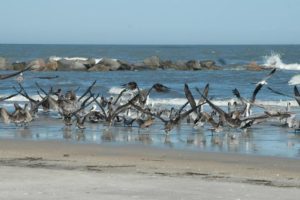President Richard Nixon signed into law the creation of Cumberland Island National Seashore, Georgia, on October 23, 1972. His action punctuated a 400-year-old journey of human and natural change that continues to this day.
Cumberland Island is the southernmost barrier island on Georgia’s Atlantic coast, between Jekyll Island on the north and Florida’s Amelia Island on the south. The island is 17.5 miles long, and between 0.5-miles and 3.0-miles wide. A large part of the National Seashore’s 36,415 acres are marshes and shallow-water flats.

The island has been inhabited and modified since pre-history. First Native American Indians lived on the island, using fire to control their environment. Then, in the 1560s, Spanish settlers came to the island, introducing horses, hogs and cattle and many European crops. Feral hogs—unpopular and being controlled—and wild horses—wildly popular and virtually untouchable—remain on the island. Later, plantations staffed by slaves grew cotton that became a famous product of the island. In the 1900s, the island became popular as a recreational area for industrial barons, with the Carnegie family owning up to 90% of the island at one time.
But as the Carnegie family lost interest in the island, they offered the property to the National Park Service. With the National Seashore proclaimed in 1972, the National Park Service began buying tracts from the Carnegies and others, creating the park. Although most of the island lies within the park boundaries, a substantial portion of the lands are still owned by private individuals, some outright and others with a life-time rights of use.
Overall, the park is minimally developed for recreation. Access is only by boat, and no facilities are provided. Visitors are limited to 300 per day; annual visitation is less than 100,000. A significant portion (about 9,000 acres) of the northern part of the island is now a federally designated wilderness area.
The park has three goals—recreation, historic preservation and nature protection. As with many National Park Service properties, these goals can come into conflict. That is particularly true for Cumberland Island, with its long history of human habitation and modification. The biological resources are not unique, but nesting by loggerhead turtles and more than 300 bird species make it a particularly rich biodiversity site. Hunting to control deer and feral hogs occurs through several specialized hunts (bow-and-arrow, primitive weapons, adult/child) annually. A total of 87 historic structures remain on the island, but most are ruins. Private development is proposed regularly for the private lands on the island and sometimes within the park, but little has been done in recent decades. Hurricane Irma in August 2017 caused sufficient damage that the park was closed for several months.
References:
Cumberland Island Conservancy. Cumberland Island. Available at: http://cumberlandisland.com/conservancy/our-mission/. Accessed October 23, 2017.
Dilsaver, Lacy M. 2004. Cumberland Island National Seashore, A History of Conservation Conflict. University of Virginia Press. Available at: https://www.nps.gov/parkhistory/online_books/cuis/dilsaver/index.htm. Accessed October 23, 2017.
Janiskee, Bob. 2010. By the Numbers: Cumberland Island National Seashore. National Parks Traveler, November 5, 2010. Available at: https://www.nationalparkstraveler.org/2010/11/numbers-cumberland-island-national-seashore7180. Accessed October 23, 2017.
Torres, Louis. 1977. Historic Resource Study, Cumberland Island National Seashore, Georgia, and Historic Structure Report, Historical Data Section of the Dungeness Area. National Park Service. Available at: https://www.nps.gov/parkhistory/online_books/cuis/hrs_hsr.pdf. Accessed October 23, 2017.
